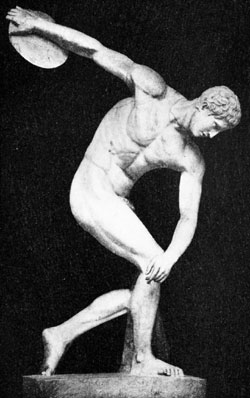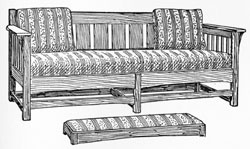Line and Form of Interior Decoration
If the nose of Cleopatra had been shorter,” observed Pascal, “the whole face of the world would have changed.” The power of line is indisputable. Yet it is clear that in itself is a mere mathematical abstraction, and that the lines drawn by the artists are after all but marks. Their power to move us lies in something outside of themselves, and the explanation of this power must be sought, not in lines and spatial forms as such, but in the nature of the mind.
Man is a creature who lies prone when he is asleep or at rest and stands erect in action. In a stern or resistant mood he stands stiff and straight; in a playful or happy mood he relaxes, and the lines of his body fall into easy curves. When he carries a load upon his shoulder his body bends into reciprocal curves-slight curves if the load is light, deeper and more angular as the load grows heavier; until finally he stoops upon one knee the better to bear up his burden, as Atlas stoops to bear up the earth. When a man is in motion he bends forward; slightly if he walks, deeply if he runs. When he encounters an opposing force he braes himself against it, and the greater the force the sharper will be the angle of his body and the straighter the line it.
Because he has been doing these things for unnumbered generations-because certain emotional states always find expression through definite positions-man associates the emotions with the lines that define their accompanying positions, so that a given line in a work of art has the power to call up into consciousness, more or less vividly, its concomitant emotional state. Thus straight lines are always associated with the ideas of steadiness and force, and curved lines with the ideas of flexibility, buoyancy and grace. And because horizontal extension is always associated with the idea of repose, and vertical extension always with the ideas of life and activity, horizontal and vertical lines, whether straight or curved, always call up, the one ideas of calmness and repose, the other ideas of activity and support. This contrast between horizontal and vertical extension is the original factor in visual esthetics, and all of what Professor Theodor Lipps calls the life quality (Lebendigkeit) of architectural and decorative forms grows out of the interplay of these activities and is expressed by the interplay and contrasts of horizontal and vertical lines.
Our emotions are stirred by spatial forms, whether natural or artistic, because we project or “feel ourselves into” them. Not only do we feel ourselves running or straining with the athlete at the games; we feel ourselves pushing upward with the column and striving upward with the tower. “The Discobolus of Myron,” says Lipps, “bows his body, throws out his arm, turns his head. Not the marble of which the statue consists does these things, but the man that the statue represents. Of the man, however, nothing is present in the statue save the form-the man-resembling spatial form (die menschenahnliche Raumgestalt) ; it is simply that this spatial form is in our imagination filled with a definite human life. The marble is the material of the representation; the object of the representation is the life bound up in the form.”
Lines as they appear in architectural and decorative design are in character straight, curved, or broken, and in direction horizontal, vertical or oblique. In composition the emotional significance of each type tends to be affirmed and intensified by the repetition of like lines, and to be contradicted and neutralised by the employment of lines of an opposing type.
The first difference in significance between straight and curved lines, as Raymond has pointed out, is the fact that the latter suggest the results of instinctive action, while the former suggest the results of reflective action. Nearly everything in nature, from grass to man himself, grows in curves. It is only when man starts to reflect and to contrive-to build temples and tombs and engines of construction and destruction-that straight lines appear. Thus they are inevitably associated with what is thoughtful, serious, purposive and austere. For this reason straight lines are employed in designing the structural elements of a room, and are emphasized in the design of furniture, rugs and hangings in the degree that the motive of the decorative unit and of the room as a whole is serious or austere.

PLATE II.- The Discus Thrower. Under the law of empathy (einfuhlung) we “feel ourselves into” spatial forms, both animate and inanimate.
The Italian chairs of the early Renaissance owed their fine air of virility and thoughtful contrivance largely to their straight lines, as do our own Craftsman and Mission chairs; but the latter, by reason of their exclusive use of such lines, reveal a quality of hardness, ungraciousness and austerity from which the former

FIGURE 4.-The effect of repose characteristic of this sofa is due to its length as opposed to its height. Its effect of hardness and austerity is due to the almost exclusive employment of straight line in its design.
Were redeemed by the saving grace of carved finials, turned arm supports, and velvet or damask coverings. The same quality of hardness through over-emphasis of straight lines is apparent in Kazak, Bokhara, Afghan and many other rugs woven by primitive Oriental peoples, and in primitive ornament generally. As the worker in any art so masters his technique that he is able to work more or less instinctively he naturally chooses to express himself more and more through the freedom, buoyancy and grace of curved lines, and to restrict his use of straight lines to situations where the significance of his work or its structural requirements demand their steadiness and force. As men and races grow in their power of seeing the beautiful they demand and increasing degree of subtlety in all forms of art-subtler ideas, and subtler modes of expression-and because straight lines are by nature direct, unvarying and obvious they more and more give place to curves.
 "Finally! Step-by-Step Guidebooks Show
"Finally! Step-by-Step Guidebooks Show